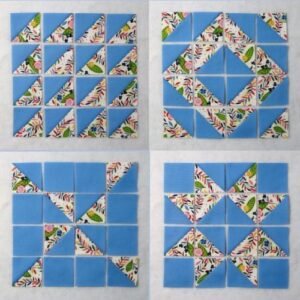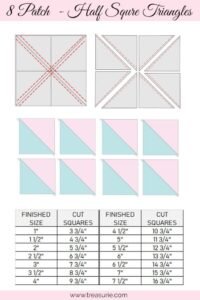The Easy Half Square Triangle Quilt Block Patterns are a fundamental part of quilting, offering a simple yet versatile design that can be used in countless projects. Whether you are a beginner or an experienced quilter, mastering half-square triangles (HSTs) can significantly enhance your quilting skills and creativity. These blocks are easy to make, require minimal fabric waste, and allow for endless pattern variations.
HST quilt blocks are created by sewing two triangles together to form a square. This technique provides a strong foundation for many classic quilt patterns, from traditional to modern designs. Learning the different ways to assemble and use HSTs can open up a world of creative possibilities, making quilting more enjoyable and rewarding.
In this article, we will explore the Easy Half Square Triangle Quilt Block Patterns in detail. We will cover different techniques to create these blocks, tips for precision, common mistakes to avoid, and some beautiful quilt layouts that you can try at home.

1. Understanding the Basics of Half Square Triangles
The half square triangle (HST) is one of the simplest and most versatile quilt blocks. It consists of two right-angled triangles sewn together to form a square. The beauty of HSTs lies in their ability to be arranged in various ways to create stunning patterns.
HSTs can be made using different methods, but the most common technique is the two-at-a-time method, which is quick and efficient. This involves sewing two squares together along the diagonal, cutting them apart, and pressing them open to reveal two identical HST units.
Choosing the right fabrics for HSTs is crucial. High-contrast fabrics work best, as they emphasize the design and create a striking visual impact. Pre-cut fabric bundles, such as charm packs or layer cakes, can be a great choice for beginners.
Accurate cutting and sewing are essential for perfect HSTs. Using a rotary cutter and ruler helps ensure clean, straight edges, while a scant 1/4-inch seam allowance keeps the pieces aligned.
Pressing seams correctly also improves accuracy. Pressing seams to one side adds stability, while pressing them open reduces bulk. The choice depends on the quilt pattern and personal preference.
Finally, trimming the HST units to the correct size ensures that the final quilt top lies flat and seams match up perfectly. A square ruler with diagonal lines can be a useful tool for this step.
2. Step-by-Step Guide to Making Half Square Triangles
To create Easy Half Square Triangle Quilt Block Patterns, follow this simple step-by-step process:
Start by choosing two fabric squares of equal size. The size of these squares will determine the final size of your HST units.
Place the two fabric squares right sides together. Draw a diagonal line from one corner to the opposite corner using a fabric marker or chalk pencil.
Sew a seam 1/4 inch away from both sides of the drawn diagonal line. This creates two parallel stitch lines that will hold the fabric together when cut.
Using a rotary cutter and ruler, cut along the drawn diagonal line to separate the two triangles. This results in two HST units from a single fabric pair.
Press the seams carefully. Depending on your pattern and fabric choice, press seams to one side or open to reduce bulk and improve accuracy.
Trim the HSTs to the required size. Use a square ruler with diagonal guidelines to ensure precision, removing any excess fabric to create neat, uniform blocks.
3. Creative Ways to Arrange Half Square Triangle Blocks

Once you have a collection of Easy Half Square Triangle Quilt Block Patterns, you can arrange them in various ways to create stunning quilt designs.
The chevron pattern is a popular choice that creates a dynamic zigzag effect. By alternating the direction of HSTs, you can achieve a striking visual impact perfect for modern quilts.
The pinwheel pattern is a classic design that uses four HSTs arranged to form a spinning effect. This layout is excellent for traditional and baby quilts.
The diamond pattern is another attractive arrangement that creates a geometric and symmetrical look. It works well with contrasting fabrics for a bold aesthetic.
The flying geese effect can be achieved by placing HSTs in rows, creating a movement illusion that is ideal for nature-inspired quilts.
The hourglass block is formed by combining HSTs in a way that resembles an hourglass shape. This timeless design adds elegance and sophistication to quilts.
The scrappy HST quilt is a great way to use leftover fabric pieces. Mixing different colors and prints creates a lively, playful quilt full of charm.
4. Common Mistakes and How to Avoid Them
Even when working with Easy Half Square Triangle Quilt Block Patterns, mistakes can happen. Here are some common pitfalls and how to prevent them.
Inaccurate cutting can lead to misshapen blocks. Always use a rotary cutter and ruler for clean, precise edges.
Uneven seams can distort HSTs. Maintaining a consistent 1/4-inch seam allowance ensures the blocks fit together perfectly.
Fabric stretching is a frequent issue when working with bias edges. Handle fabric gently and use starch spray to add stability.
Skipping the trimming step can result in uneven quilt tops. Always trim HSTs to the correct size before piecing them together.
Pressing mistakes can affect accuracy. Use a hot iron with steam to press seams carefully without distorting the fabric.
Neglecting color contrast can make patterns less defined. Choose fabrics with high contrast to highlight the HST designs effectively.
FAQ
What is the best fabric for making half square triangles? Cotton fabric is the best choice for HSTs due to its stability and ease of handling.
Can I make half square triangles without drawing a diagonal line? Yes, you can use pre-cut templates or specialty rulers that eliminate the need for marking.
What is the fastest way to make multiple HSTs at once? The eight-at-a-time method allows you to create multiple HSTs quickly by sewing two large squares together and cutting them into eight sections.
Why do my HSTs turn out too small? Inaccurate seam allowances and fabric shrinkage can cause this. Double-check your measurements and use a scant 1/4-inch seam.
How do I prevent fabric from fraying when making HSTs? Using pinking shears or fabric starch can help reduce fraying along the bias edges.
PATTERH HERE
Mastering Easy Half Square Triangle Quilt Block Patterns is a valuable skill for any quilter. With simple techniques and creative arrangements, HSTs can be transformed into beautiful quilts suitable for any occasion. Whether you are making a traditional quilt or experimenting with modern designs, HSTs provide endless opportunities for creativity.
We hope this guide has been helpful! Feel free to share your thoughts, experiences, or suggestions in the comments. Happy quilting!





